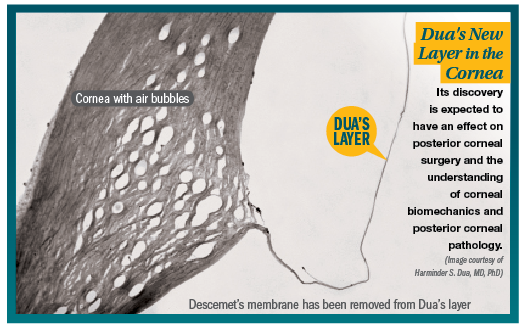Article
New layer to human cornea discovered
The discovery of a new layer in the cornea has many surgical and clinical implications. This layer can support the endothelium in the procedure of endothelial keratoplasty, making the handling of Descemet’s membrane transplant safer and technically simpler, according to its discoverer Harminder S. Dua, MD, PhD.
Take-home
The discovery of a new layer in the cornea has many surgical and clinical implications. This layer can support the endothelium in the procedure of endothelial keratoplasty, making the handling of Descemet’s membrane transplant safer and technically simpler, according to its discoverer Harminder S. Dua, MD, PhD.

Dua's new layer in the cornea: Its discovery is expected to have an effect on posterior corneal surgery and the understanding of corneal biomechanics and posterior corneal pathology (Image courtesy of Harminder S. Dua, MD, PhD)
Nottingham, England-Scientists have discovered a new layer in the cornea.
This previously undetected layer located in the pre-Descemet’s cornea is well-defined, acellular, strong enough to withstand up to 1.5 to 2.0 bars of pressure, and has been named Dua’s layer, after Harminder S. Dua, MD, PhD, who discovered it.

Dr. Dua
“Clinical implications of this layer will emerge with time, but the surgical implications are immediately relevant,” said Dr. Dua, professor of ophthalmology and visual sciences, University of Nottingham, Queens Medical Centre, Nottingham, England.
“This layer can also be used to support the endothelium in the procedure of endothelial keratoplasty, making the handling of the Descemet’s membrane transplant safer and technically simpler,” Dr. Dua said.
To define and characterize the novel pre-Descemet’s layer in the cornea, Dr. Dua and colleagues at the University of Nottingham performed a study, currently in press at Ophthalmology, in which they included 31 human donor sclerocorneal discs and 6 controls.
Big bubble technique
Using the big bubble (BB) technique, they injected air into the stroma of donor whole globes (n = 4) and sclerocorneal discs (n = 21), similar to what is done in the deep anterior lamellar keratoplasty procedure. They then performed the following:
- Creation of BB, followed by peeling of the Descemet’s membrane;
- Peeling off the Descemet’s membrane, followed by creation of the bubble; and
- Creation of the BB and continued inflation until the bubble popped to measure popping pressure.
The tissue they obtained from these experiments also underwent histologic examination.
Three types of BB were obtained:
- Type 1: a well-circumscribed, central, dome-shaped elevation to 8.5-mm diameter (n = 14).
- Type 2: a thin-walled, large BB (maximum: 10.5-mm diameter), which consistently started at the periphery and enlarged centrally (n = 5).
- Type 3: a mixed type of bubble (n = 3).
In Type 1 BB, the Descemet’s membrane could be peeled off without deflating the BB, indicating the presence of another layer of tissue. In Type 2 BB, this was not possible. Type 1 BBs could be created even after initial peeling of the Descemet’s membrane (n = 5), and this confirmed that the Descemet’s membrane was not necessary to create this type of BB.
Popping pressures were 1.45 bar for the Type 1 BB, and 0.6 bar for the Type 2 BB. Histologically confirmed cleavage occurred after the last row of keratocytes. The new layer was found to be acellular, 10.15 μm in diameter, and composed of five to eight lamellae of predominantly type-1 collagen bundles arranged in transverse, longitudinal, and oblique directions.
Feeling the impact
According to Dr. Dua, his discovery will immediately have an effect on surgery in the posterior cornea and the gradual understanding of corneal biomechanics and posterior corneal pathologies, including acute hydrops, Descemetocole, and pre-Descemet’s dystrophies.
Clinically, his discovery will also impact the understanding of several corneal pathologies.
“There are several conditions that affect the back part of the corneal stroma,” Dr. Dua said. “The consequences or sequelae of these could relate to this layer and is something that we are currently investigating.
“For example, it is traditionally believed that a sudden water logging of the cornea (acute hydrops) that occurs in keratoconus (dystrophy of the corneal causing progressive ectasia) is due to a break in the Descemet’s membrane,” he added. “We have hypothesized that this may be due to a break in the Descemet’s membrane and the Dua’s layer. This not proven, but is something we are investigating.”
Surgically, Dr. Dua’s discovery may help explain a few inconsistencies as well.
“Thus far, all surgeons thought that they were separating the Descemet’s membrane from the stroma in . . . deep anterior lamellar keratoplasty,” he said. “We have proved that this is not so, but that this new layer offers the plane of cleavage in most cases (more than 80% of times), and because it is so tough, it keeps the eye much stronger than it would have been if only Descemet’s membrane was left behind or in a PK. Knowledge of this layer will now enable surgeons to understand the operation better and make it safer,” he said.
But is he surprised by his discovery?
“I am pleased by my discovery as it explains a few things that were happening during lamellar corneal surgery that we did not previously understand,” Dr. Dua said. “It will make the operation safer and may also improve our understanding of some corneal diseases.”
Reactions to discovery of new corneal layer
Aside from suggesting the need for medical textbooks to be rewritten, the significance of Dr. Dua’s discovery of a new corneal layer will take time to become realized.
“It will require, in my opinion, some time to see if others can confirm the existence of this ‘new layer’ and its potential significance,” said Peter J. McDonnell, MD, director of the Wilmer Eye Institute, Johns Hopkins University School of Medicine, Baltimore, and chief medical editor of Ophthalmology Times.
“My view is that this is an interesting and provocative report from a well-respected research group,” he said. “My reading of their paper is that this is not a description of a new layer in the sense of how we think of the corneal layers (epithelium, basement membrane, Bowman’s layer, etc.), in which the composition is distinct and readily appreciated as such on light and electron microscopy (or even at the slit lamp).”
Rather, this is more the suggestion that a region of the deep stromal layer has a somewhat distinct set of physical and mechanical properties from the rest of the more anterior stroma, he noted.
“So, it will be interesting to see how other means of testing for this confirm or refute the finding and to what degree this might prove to have clinical significance,” Dr. McDonnell concluded.
Also weighing in on this new approach is Mark A. Terry, MD, director, Corneal Services, Devers Eye Institute, and professor of clinical ophthalmology, Oregon Health Sciences University, Portland.
“Dr. Dua has taken a new approach to looking at the posterior layers of the cornea and proposes that because the posterior layers of the stroma just anterior to Descemet's membrane react differently to our surgical maneuvers than say, the mid stroma, that this property qualifies this layer as separate anatomical entity,” Dr. Terry said.
This concept of a new layer is seen by some as intellectually “splitting hairs” of terminology, whereas others see it as legitimately “splitting cornea,” he said.
“Dr. Dua’s concept is not without precedent, as Dr. Bowman also recognized the unique qualities of the most anterior layer of the cornea (which bears his name) nearly a century ago,” Dr. Terry concluded. “I applaud the fresh approach to corneal anatomy that Dr. Dua has taken, and I look forward to further documentation of the unique benefits of this layer in the treatment of our patients.”
Harminder S. Dua, MD, PhD
E: harminder.dua@nottingham.ac.uk
Dr. Dua did not indicate any proprietary interest in the subject matter.
Subscribe to Ophthalmology Times to receive the latest clinical news and updates for ophthalmologists.
Newsletter
Don’t miss out—get Ophthalmology Times updates on the latest clinical advancements and expert interviews, straight to your inbox.




